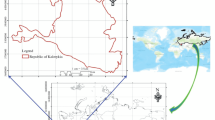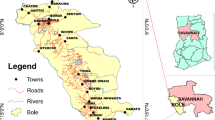Abstract
Two-thirds of the total area of Taiwan is mountainous terrain, which is the main groundwater recharge source of the plains region. This study assesses groundwater recharge and exploitative potential zone in the central division of the mountain areas of Taiwan (the middle reaches of the Jhuoshuei River Basin). Basic information from remote sensing and a satellite phantom is collected to set up the basic data maps using elevation, Formosa-II images, the Normalized Difference Vegetation Index, drainage distribution, slope, aspect ratio, lineament distribution, and land cover. A geographical information system is used to integrate five contributing factors, namely lithology, land cover/land use, drainage, slope, and lineaments. The criteria for the recharge potential assessment are established to demarcate the potential groundwater recharge zone. Finally, the GOD rating system is adopted to evaluate the potential exploitation zone. Three main parameters are considered: the groundwater occurrence, the lithology of the overlying layers, and the depth to groundwater. The results show that the middle reaches of the Chenyuland River have large potential exploitation zones due to its high rainfall recharge capacity. Regions west of the Jhuoshuei River and the downstream regions of the Chingshui River are medium potential exploitation zones because of their high infiltration rates and shallow groundwater levels.










Similar content being viewed by others
References
Adham MI, Jahan CS, Mazumder QH, Hossain MMA, Haque A (2010) Study on groundwater recharge potentiality of Barind Tract, Rajshahi District, Bangladesh using GIS and remote sensing technique. J Geol Soc India 75:432–438
CGS (2010) Groundwater resources investigation in Mid-Taiwan Mountain Region Project. Ministry of Economic Affairs of the Republic of China, Central Geological Survey, Taiwan
Chowdhury A, Jha MK, Chowdary VM (2010) Delineation of groundwater recharge zones and identification of artificial recharge sites in West Medinipur district, West Bengal, using RS, GIS and MCDM techniques. Environ Earth Sci 59:1209–1222
Edet AE, Okereke CS, Teme SC, Esu EO (1998) Application of remote sensing data to groundwater exploration: a case study of the Cross River State, southeastern Nigeria. Hydrogeol J 6:394–404
El-Baz F, Himida I (1995) Groundwater potential of the Sinai Peninsula, Egypt. Project Summary, AID, Cairo
Foster SSD (1987) Fundamental concepts in aquifer vulnerability, pollution risk and protection strategy. In: van Duijvenbooden W, van Waegeningh HG (eds) TNO Committee on Hydrological Research, The Hague. Vulnerability of soil and groundwater to pollutants, proceedings and information, vol 38, pp 69–86
Greenbaum D (1985) Review of remote sensing applications to groundwater exploration in basement and regolith. Br Geol Surv Rep OD 85:36
Hsu KC, Wang CH, Chen KC, Chen CT, Ma KW (2007) Climate-induced hydrological impacts on the groundwater system of the Pingtung Plain, Taiwan. Hydrogeol J 15:903–913
Jaiswal RK, Mukherjee S, Krishnamurthy J, Saxena R (2003) Role of remote sensing and GIS techniques for generation of groundwater prospect zones towards rural development—an approach. Int J Remote Sens 24:993–1008
Jha MK, Chowdhury A, Chowdary VM, Peiffer S (2007) Groundwater management and development by integrated remote sensing and geographic information systems: prospects and constraints. Water Resour Manage 21:427–467
Lattman LH, Parizek RR (1964) Relationship between fracture traces and the occurrence of groundwater in carbonate rocks. J Hydrol 2:73–91
Leduc C, Favreau G, Schroeter P (2001) Long-term rise in a Sahelian water table: the Continental Terminal in southwest Niger. J Hydrol 243:43–54
Lin HI, Yeh HF, Lee ST, Hsu KC, Lee CH, Huang CC, Chang MH (2011) Groundwater recharge and exploitative potential zone mapping using RS and GIS in the Central Division of Jhuoshuei River Basin, Taiwan, HS04-A011. Asia Oceania Geosciences Society, Taipei
Mukherjee S (1996) Targeting saline aquifer by remote sensing and geophysical methods in a part of Hamirpur-Kanpur, India. Hydrogeol J 19:53–64
Murthy KSR (2000) Groundwater potential in a semi-arid region of Andhra Pradesh—a geographical information system approach. Int J Remote Sens 21:1867–1884
NRSA (1987) Land and water resources survey of drought affected district-Kolar, Karnataka. Technical Report, National Remote Sensing Agency, Hyderabad
O’Leary DW, Friedman JD, Poh HA (1976) Lineaments, linear, lineations: some standards for old terms. Geol Soc Am Bull 87:1463–1469
Salama RB, Tapley I, Ishii T, Hawkes G (1994) Identification of areas of recharge and discharge using Landsat-TM satellite imagery and aerial photography mapping techniques. Hydrogeol J 162:119–141
Shaban A, Khawlie M, Abdallah C (2006) Use of remote sensing and GIS to determine recharge potential zone: the case of Occidental Lebanon. Hydrogeol J 14:433–443
Singh AK, Prakash SR (2002) An integrated approach of remote sensing, geophysics and GIS to evaluation of groundwater potentiality of Ojhala sub-watershed. Mirjapur district, UP, India, http://www.GISdevelopment.net
Solomon S, Quiel F (2006) Groundwater study using remote sensing and geographic information system (GIS) in the central highlands of Eritrea. Hydrogeol J 14:1029–1041
Tweed SO, Leblanc M, Webb JA, Lubczynski MW (2007) Remote sensing and GIS for mapping groundwater recharge and discharge areas in salinity prone catchments, southeastern Australia. Hydrogeol J 15:75–96
Wang CH (2007) The impacts of climate change on the groundwater environment of Taiwan. Bull Central Geol Surv Minist Econ Affairs 18:239–255 (in Chinese)
Yeh HF, Lee CH, Hsu KC, Chang PH (2009) GIS for the assessment of groundwater recharge potential zone. Environ Geol 58:185–195
Acknowledgments
The authors would like to thank the Central Geological Survey of the Ministry of Economic Affairs of the Republic of China, Taiwan, for financially supporting this research under Grant 99-5226904000-06-02.
Author information
Authors and Affiliations
Corresponding author
Rights and permissions
About this article
Cite this article
Huang, CC., Yeh, HF., Lin, HI. et al. Groundwater recharge and exploitative potential zone mapping using GIS and GOD techniques. Environ Earth Sci 68, 267–280 (2013). https://doi.org/10.1007/s12665-012-1737-5
Received:
Accepted:
Published:
Issue Date:
DOI: https://doi.org/10.1007/s12665-012-1737-5




